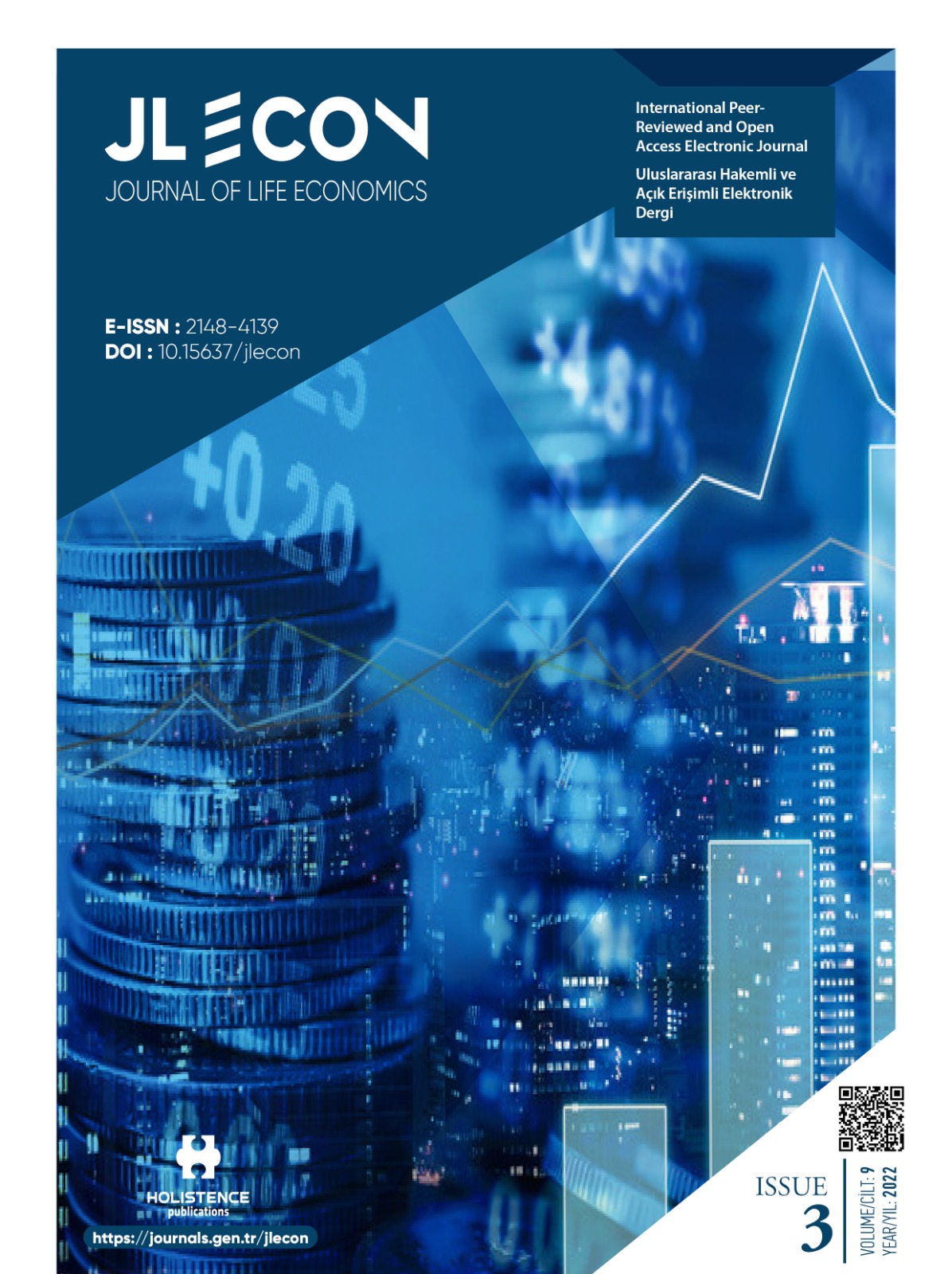The relationship between interest, exchange rate and inflation in BRICS-T countries: Panel cointegration analysis
DOI:
https://doi.org/10.15637/jlecon.9.3.01Keywords:
Interest rate, inflation, exchange rate, fisher hypothesis, panel data analysisAbstract
Inflation, one of the most serious economic problems of the modern era, has risen to the top of the priority list for economic management, monetary, and fiscal policies in both developed and developing countries. While cyclical fluctuations in food and energy supply and demand create inflationary pressures, such pressures can cause major problems with interest and exchange rates in developing countries with insufficient financial depth. There are numerous factors that contribute to high inflation, which is a significant issue for developing economies. One of the primary goals of economic management is to eliminate the direct and indirect effects of high inflation on economies. In the study, the relationship between inflation, exchange rate and interest rates has been evaluated in terms of BRICS countries (Brazil, Russia, India, China, South Africa) and Türkiye. The nature of the relationship between interest, exchange rate and inflation was attempted to be determined using panel data tests and consumer price index and interest rate data for the 1996M10-2021M12 periods. According to the research findings, as the dollar rate variable gains value against the local currencies (excluding the Russian Ruble), the countries’ consumer price levels rise. This is also true for the common Panel. When we examine the effect of the interest rate variable on the consumer price level on a country by-country basis, we see that it is negative in Brazil, China, and South Africa, but positive in Russia and Türkiye.
Downloads
References
ADAM, A. M. & OFORI, D. (2017). Validity of International Fisher Effect in the West African Monetary Zone. Journal of Economic Cooperation and Development. 38(3), 121-144.
ADEGBOYEGA, S. B., ODUSANYA, I. A. & R.O. POPOOLA (2013). Fisher’s Effect in Nigeria: Empirical Analysis Using ARDL (Bound Test) Approach, International Journal of Science and Research. 12(2), 378-382.
AHMAD, S. (2010). The Long Run Fisher Effect in Developing Countries, Studies in Economics and Finance. 27 (4), 268 275.
AKSU, H., & EMSEN, Ö. S. (2019). Enflasyon, Faiz ve Döviz Kuru İlişkileri: Türkiye İçin ARDL Analizleri İle Asimetrik Eş-Bütünleşme Araştırması (2003: 01-2017: 12). Ataturk University Journal of Economics & Administrative Sciences, 33(1).
AKUFFO, B., ABLEDU, G. K. & AMPAW ,E. M. (2014). A Cointegration analysis of inflation and interest rate volatility in Ghana (2003:01 – 2013:12). ADRRI Journal of Arts and Social Sciences. Vol. 3, No.3 (1).
ALACAHAN, N. D. (2011). Enflasyon, Döviz Kuru İlişkisi ve Yansıma: Türkiye. Sosyal Bilimler Dergisi. (1), 49-56.
ALPER, F. Ö. (2017). Türkiye’deki Enflasyon ve Nominal Faiz Oranı İlişkisinin Analizi: Bayer Hanck Eşbütünleşme Testi. 3rd International Congress on Political, Economic and Social Studies (ICPESS). 09-11 Nov., Niğde.
ALTUNÖZ, U. (2018). Investigating the Presence of Fisher Effect for the China Economy. Investigating the Presence of Fisher Effect for the China Economy, Sosyoekonomi. 26(35), 27 40.
ALVAREZ, F., LUCAS, R. E., & WEBER, W. E. (2001). Interest rates and inflation. American Economic Review. 91(2), 219-225.
ANDREA, S. O. & RODRIGO, G. M. (2015). Finding International Fisher Effect to Determine The Exchange Rate Through The Purchasing Power Parity Theory: The Case of Mexico During The Period 1996-2012. Applied Econometrics and International Development. 15(1), 97-110.
ARISOY, I. (2013). Testing For The Fisher Hypothesis Under Regime Shifts in Türkiye: New Evidence From Time–Varying Parameters. İnternational Journal Of Economics and Financial Issues. 3(2), 496-502.
ARSHAD, S. & ALİ, A (2016). Trade-off between Inflation, Interest and Unemployment Rate of Pakistan: Revisited. Bulletin of Business and Economics. 5(4), 193-209.
ASARI, F. F. A. H., BAHARUDDİN, N. S., JUSOH, N., MOHAMAD, Z., SHAMSUDIN, N., & JUSOFF, K. (2011). A Vector Error Correction Model (Vecm) Approach In Explaining The Relationship Between Interest Rate And Inflation Towards Exchange Rate Volatility in Malaysia. World Applied Sciences Journal, 12(3), 49-56.
ASEMOTA, O. J. ; BALA, D. D. VE HARUNA, Y. (2015). Fisher Effect, Structural Breaks and Outliers Detection in ECOWAS Countries, International Journal of Statistics and Applications, 5(5), 181 195.
ATGÜR M. & ALTAY, N. O. (2015). Enflasyon ve Nominal Faiz Oranı İlişkisi: Türkiye Örneği (2004 2013). Yönetim ve Ekonomi, 22, 521-533.
ATKINS, J. FRANK &COE, PATRİK, J. (2002). An ARDL Bounds Test of the Long Run Fisher Effect in the United States and Canada. Journal of Macroeconomics, 24(2), 255 266.
AYUB, G., REHMAN, N.U., IQBAL, M., ZAMAN, Q. & ATİF, M. (2014). Relationship between Inflation and Interest Rate: Evidence from Pakistan. Research Journal of Recent Sciences, 3(4), 51-55.
BACİ, D. (2007). Revisiting Fisher Effect for Developed and Developing Countries: A Bounds Test Approach. Yayınlanmamış Yüksek Lisans Tezi, Orta Doğu Teknik Üniversitesi- Sosyal Bilimler Enstitüsü.
BAİ, J., & S. NG. (2004). A Panic Attack on Unit Roots and Cointegration. Econometrica, 72 (4):1127–1178.
BAJO-RUBIO, O., DIAZ-ROLDAN, C. & ESTEVE, V. (2005). Is the Fisher effect nonlinear? Some evidence for Spain, 1963-2002. Applied Financial Economics, 15(12), 849-854. doi: 10.1080/09603100500123187.
BAKTEMUR, F. İ. (2021). Enflasyon ile faiz oranları arasındaki doğrusal olmayan nedensellik ilişkisi: Türkiye örneği. İstanbul Ticaret Üniversitesi Sosyal Bilimler Dergisi, 20(42), 1147 1158. doi: 10.46928/iticusbe.799437.
BAL, O. (2012), Döviz kuru, mevduat faiz oranı, enflasyon ve devlet iç borçlanma senetleri ilişkisi: 1994- 2008, Akademik Bakış Dergisi, 31, 1-20.
BALTAGI, B. H., FENG, Q., & KAO, C. (2012). A Lagrange Multiplier test for cross-sectional dependence in a fixed effects panel data model. Journal of Econometrics, 170(1), 164-177.
BAŞAR, S. & KARAKUŞ, K. (2017). Fisher Hipotezi: Türkiye İçin Tahmini. Uluslararası Sosyal Araştırmalar Dergisi, 10(54), 794-803.
BAYAT, T. (2011). Türkiye’de Fisher Etkisinin Geçerliliği: Doğrusal Olmayan Eşbütünleşme Yaklaşımı. Erciyes Üniversitesi İktisadi ve İdari Bilimler Fakültesi Dergisi, (38), 47-60.
BAYAT, T., KAYHAN, S. & TASAR, I (2018). Re-Visiting Fisher Effect for Fragile Five Economies. Journal of Central Banking Theory and Practice, 2, 203-218.
BENAZIĆ, M. (2013). Testing the Fisher Effect in Croatia: An Empirical Investigation. Economic Research, 26(1), 83-102.
BERUMENT, H. & JELASSI, M.M. (2002). The Fisher Hypothesis: A Multi-Country Analysis. Applied Economics, (34), 1645-1655.
BODIE, Z., KANE, A., & MARCUS, A. (2014). E-book: Investments-Global edition. McGraw Hill. BOLATOĞLU, N. (2006). Türkiye’de Enflasyon ve Nominal Faiz Oranları Arasındaki Uzun Dönemli İlişki: Fısher Etkisi. Hacettepe Üniversitesi İktisadi ve İdari Bilimler Fakültesi Dergisi, 24(2), 1-15.
BONHAM, C. (1991). Correct Cointegration Test of the Long Run Relationship between Nominal Interest Rate and Inflation, Applied Economics, 23, 1487 1492.
BOOTH, G. G. & CİNER, C. (2001). The Relationship Between Nominal Interest Rates And Inflation: International Evidence, Journal of Multinational Financial Management, 11(3), 269 280.
BREUSCH,T.S. & PAGAN, A.G. (1980). The Lagrange Multiplier Test and its Applications to Model Specification in Econometrics, The Review of Economic Studies, 47 (1), 239–253, https://doi.org/10.2307/2297111
BULUT, E. (2005), Döviz Kuru Belirleme Modelleri ve Döviz Piyasasının Mikro Yapısı: Türkiye Örneği”, Gazi üniversitesi, Sosyal Bilimler Enstitüsü, Yüksek Lisans Tezi.
CARNEIRO, F. G., ÂNGELO, J., DIVINO IV, C. A., &ROCHA, C. H. (2002). Revisiting the Fisher hypothesis for the cases of Argentina, Brazil and Mexico. Applied Economics Letters, 9(2), 95 98.
CHOI, I. (2001). Unit Root Tests for Panel Data. Journalof International Money and Finance 20: 249–272.
CHOI, I. (2002). Combination Unit Root Tests for Cross-Sectionally Correlated Panels. Mimeo: Hong Kong University of Science and Technology.
DAS, P. (2019). Econometrics in Theory and Practice, Analysis of Cross Section, Time Series and Panel Data with Stata 15.1. Springer, 528-529 ISBN 978-981-32-9018-1 ISBN 978-981-32-9019-8 (eBook) https://doi.org/10.1007/978-981-32-9019-8
DOĞAN, B., EROĞLU, Ö., & DEĞER, O. (2016). Enflasyon ve faiz oranı arasındaki nedensellik ilişkisi: Türkiye örneği. Çankırı Karatekin Üniversitesi İktisadi ve İdari Bilimler Fakültesi Dergisi, 6(1), 405-425.
DOĞAN, I., ORUN, E., AYDIN, B. & AFSAL, M.S. (2020). Non-parametric analysis of the relationship between inflation and interest rate in the context of Fisher effect for Turkish economy. International Review of Applied Economics, 34(6), 758-768. doi: 10.1080/02692171.2020.1782852.
EMSEN, S. (2003). Ekonomik Krizler ve Türkiye Deneyimi. Beta Basım Yayım.
GEDİK, A. (2021). Enflasyon ve Faiz Oranı İlişkisi: Fisher Hipotezinin Türkiye İçin Geçerliliği . Avrupa Bilim ve Teknoloji Dergisi , (27) , 615-624 . DOI: 10.31590/ejosat. 989935
GRANVILLE, B. & MALLICK, S. (2004). Fisher Hypothesis: UK Evidence over a Century. Applied Economics Letters, 11(2), 87-90.
GURSIDA, H. (2018). The Influence Of Inflation Rate, Interest Rate, And Money Supply On Share Price LQ45. Sinergi: Jurnal Ilmiah Ilmu Manajemen, 8(1).
GÜL, E. & AÇIKALIN, S. (2007). An Examination of the Fisher Hypothesis: The Case of Türkiye. Applied Economics, 10(1), 1-5.
GÜVEN, E. T. A., & UYSAL, D. (2013). Türkiye’de Döviz Kurlarındaki Değişme İle Enflasyon Arasındaki İlişki (1983-2012). Akademik Araştırmalar ve Çalışmalar Dergisi (AKAD), 5(9), 141 156.
HADRI, K. (2000). Testing for stationarity in heterogeneous panels. Econometrics Journal, 3: 148–161.
HERWATZ, H. & REIMERS, H. E. (2006). Panel Nonstatıonary Tests Of The Fisher Hypothesis: An Analysis of 114 Economies During The Period 1960-2004, Applied Econometrics and International Development, 6(3), 37-53.
HSIAO, C. (1986). Analysis of Panel Data, Cambridge University Press: Cambridge.
HSIAO, C. (2014). Analysis of Panel Data, Econometric Society Monographs. Cambridge University Press. Third Edition. ISBN: 1107038693,9781107038691
IM, K.S., M.H. PESARAN, & Y. SHİN. (2003). Testing for Unit Roots in Heterogeneous Panels. Journal of Econometrics, 115: 53–74.
ITO, T., & SATO, K. (2008). Exchange rate changes andinflation in post‐crisis Asian Economies: Vector Autoregression Analysis of the exchange rate pass‐through. Journal of Money, Credit and Banking, 40(7), 1407-1438.
İNCEKARA, A., DEMEZ, S. & USTAOĞLU, M. (2012). Validity of Fisher effect for Turkish Economy: Cointegration Analysis, Procedia - Social and Behavioral Sciences, 58, 396-405.
JOOF, F., & JALLOW, O. (2020). The Impact of Interest Rate and Inflation on the Exchange Rate of the Gambia. International Journal of Economics, Commerce and Management, United Kingdom, 8.
KARACAN, R. (2010), “Faiz, Kur ve Makroekonomik Performans: Türkiye Üzerine Bir İnceleme” Kocaeli Üniversitesi, Sosyal Bilimler Enstitüsü, Doktora Tezi.
KAYGISIZ, A. D., & İŞCAN, H. (2019). Türkiye’de döviz kuru, enflasyon ve faiz oranı ilişkisi: 2009 2017 uygulaması. Iğdır Üniversitesi Sosyal Bilimler Dergisi, (17), 581-604.
KHAN, R. E. A., AND GILL, A. R. (2010). Determinants of Inflation: A case of Pakistan (1970 2007). Journal of Economics, 1(1), 45-51.
KÜÇÜKAKSOY, İ. & AKALIN, G. (2017). Fisher Hipotezi’nin Panel Veri Analizi ile Test Edilmesi: OECD Ülkeleri Uygulaması, Hacettepe Üniversitesi İİBF Dergisi, 35(1), 19-40.
KÜNÜ, S., BAŞAR, S., & BOZMA, G. (2017). Gibson paradoksunun gelişmiş ve gelişmekte olan ülkeler açısından geçerliliğinin araştırılması. Gazi Üniversitesi İktisadi ve İdari Bilimler Fakültesi Dergisi, 19/1(2017), 211–222.
LEVIN, A., C.F. LIN, & C.S.J. CHU. (2002). Unit Root Test in Panel Data: Asymptotic and Finite Sample Properties. Journal of Econometrics, 108: 1–24.
MADDALA, G.S. & WU, S. (1999). A Comparative Study of Unit Root Tests with Panel Data and a New Simple Test, Oxford Bulletin of Economics and Statistics (Special Issue), 631–652.
MAHMOOD, Y., BOKHARI, R., & ASLAM, M. (2013). Trade-Off Between Inflation, Interest and Unemployment Rate of Pakistan: A Cointegration Analysis. Pakistan Journal of Commerce and Social Sciences, 7(3), 482-492.
MAKI, D. (2003). Nonparametric cointegration analysis of the nominal interest rate and expected inflation rate, Economics Letters, 81(3), 349–354. doi: 10.1016/ S0165-1765(03)00216-7.
MANKIW, N.G. (2007). Macroeconomics, Worth Publishers, New York and Basingstoke. MCCALLUM, B. T. (1989). Monetary Economics Theory and Policy. New York: Collier Macmillan Publishers.
MISHKIN, F. S. (1991). Is the Fisher Effect for Real? A Reexamination of the Relationship Between Inflation and Interest Rates. NBER Working Paper, No. 3632, 1– 64.
MISHKIN, F.S. & SİMON, J. (1995). An Empirical Examination of the Fisher Effect in Australia, https://www.nber.org/papers/w5080.pdf (10.05.2021).
MISHKIN, F.S. (1992). Is Fisher Effect For Real: A Re-examination of the Relationship between Inflation and Interest Rates, Journal of Monetary Economics, 30, 195-215.
MOON, H.R., & PERRON. B. (2004). Testing for a Unit Root in Panels with Dynamic Factors. Journal of Econometrics, 122: 81–126.
MUNDELL, R. (1963). Inflation and real interest, Journal of Political Economy, 71:280 283.
MURSHED, M. , ALİ, S. R. & BANERJEE, S. (2021). Consumption of liquefied petroleum gas and the EKC hypothesis in South Asia: evidence from cross-sectionally
dependent heterogeneous panel data with structural breaks. Energ. Ecol. Environ. 6(4):353 377 https://doi.org/10.1007/s40974-020-00185-z
NUSAIR, S. A. (2008). Testing for the Fisher hypothesis under regime shifts: an application to Asian countries. International Economic Journal, 22(2), 273-284.
ÖNDER, Ş. (2008). Enflasyon Hedeflemesi ve Döviz Kuru-Enflasyon Arasındaki Geçişkenlik: Türkiye Örneği, Hacettepe Üniversitesi, Sosyal Bilimler Enstitüsü, Yüksek Lisans Tezi.
ÖZCAN, B. &ARI, A., (2015). Does The Fisher Hypothesis Hold For The G7? Evidence From The Panel Cointegration Test, Economic Research, 28(1), 271-283.
ÖZEL, S. (2000). Türkiye’de enflasyon, devalüasyon ve faiz. Alkım Yayıncılık ve Eğitim Hizmetleri Limited Şti.
PEDRONI, P. (1999). Critical values for cointegration tests in heterogeneous panels with multiple regressors. Oxford Bulletin of Economics and statistics, 61(S1), 653-670.
PERSYN, D. & WESTERLUND, J. (2008). Error-correction– based cointegration tests for panel data. The Stata Journal. 8 (2), 232–241.
PESARAN, M. H. (2004). General Diagnostic Test for Cross Section Dependence in Panels. IZA Discussion Paper No. 1240
PESARAN, M. H. (2007). A Simple Panel Unit Root Test in the Presence of Cross‐Section Dependence. Journal of Applied Econometrics, 22(2), 265-312.
PESARAN, M. H.(2006), Estimation and Inference in Large Heteroge-neous Panels wiht A Multifactor Error Structure, Eco-nometrica, 74(4), 967-1012.
PESARAN, M.H. (2003). A Simple Panel Unit Root Test
in the Presence of Cross Section Dependence, mimeo, Cambridge University.
PHILLIPS, P.C.B. & SUL, D. (2003), .Dynamic Panel Estimation and Homogeneity Testing Under Cross Section Dependence., Econometrics Journal, 6(1), 217-259.
SAHU, T. N. (2016). Macroeconomic variables and security prices in India during the liberalized period. Springer.
SATHYE, M., SHARMA, D. & LİU, S. (2008). The Fisher Effect in an Emerging Economy: The Case of India. International Business Research, 1(2), 99-104.
SONGUR, M. (2019). Fourier Yaklaşımı ile Fisher Hipotezini Yeniden Gözden Geçirmek: Türkiye Örneği. S.C.Ü. İktisadi ve İdari Bilimler Dergisi, 20(2), 1 – 15.
ŞİMŞEK, M., & KADILAR, C. (2006). Fisher etkisinin Türkiye verileri ile testi. Doğuş Üniversitesi Dergisi, 7(1), 99-111.
TABAN, S. & ŞENGÜR, M. (2016). Türkiye’de Enflasyonun Kaynağının Belirlenmesine Yönelik Ekonometrik Bir Analiz. Erciyes Üniversitesi İktisadi ve İdari Bilimler Fakültesi Dergisi, 47, 47 64.
TORUN, M. & KARANFİL, M. (2016). 1980-2013 Dönemi Türkiye Ekonomisinde Enflasyon ve Faiz Oranı Arasındaki İlişki. Yönetim Bilimleri Dergisi, 14(27), 473- 490.
TUNALI, H. & ERÖNAL, Y. Y. (2016). Enflasyon ve Faiz Oranı İlişkisi: Türkiye’de Fisher Etkisinin Geçerliliği. Süleyman Demirel Üniversitesi İktisadi ve İdari Bilimler Fakültesi Dergisi, 21(4), 1415-1431.
TURGUT, E., & OKYAY, U. (2019). Yolsuzluğun Vergi Oranları İle Olan İlişkisinin OECD Ülkeleri Örnekleminde İncelenmesi. Niğde Ömer Halisdemir Üniversitesi Sosyal Bilimler Enstitüsü Dergisi, 1(3), 1-17.
TURGUTLU, E. (2004). Fisher Hipotezinin Tutarlılığının Testi: Parçalı Durağanlık ve Parçalı Koentegrasyon Analizi, Dokuz Eylül Üniversitesi İİBF. Dergisi, 19(2).
UĞUR, B. (2019). G-7 Ülkelerinde Enflasyon ve Faiz Haddi Arasındaki İlişkinin İncelenmesi: Fisher Etkisi. Sakarya İktisat Dergisi, 8(2), 85-99.
WESTERLUND, J. (2008). Panel Cointegration Tests of the Fisher Effect, Journal of Applied Econometrics, 23, 193-233.
WESTERLUND, J. (2005). Panel Cointegration Tests of the Fisher Hypothesis, Lund University, Department of Economics Working Papers, (10), 1-35, http://lup.lub.lu. se/search/ws/files/5491579/2061469 (05.10.2021).
WU, Y. (1996). Are Real Exchange Rates Nonstationary? Evidence From a Panel Data Test, Journal of Money, Credit and Banking, 28: 54–63.
YAMAK, R. & ABDİOĞLU, Z. (2007). Fisher Hipotezinin Testi: Güçlü ve Zayıf Form. Kahramanmaraş Sütçü İmam Üniversitesi Sosyal Bilimler Dergisi, 4(1-2), 1 - 9.
YILANCI, V. (2009). Fisher Hipotezinin Türkiye için Sınanması: Doğrusal Olmayan Eşbütünleşme Analizi. Atatürk Üniversitesi İktisadi ve İdari Bilimler Dergisi, 23(4), 205 – 213.
YILDIRIM, C., (2016). Tüketici Fiyat Endeksi ile Faiz Oranı İlişkisinin Ekonometrik Bir İncelemesi , Kastamonu Üniversitesi İİBF Dergisi, (12), ss 431-445.
YILDIZ, Ş. & BAŞAR, S. (2018). Türkiye’de Enflasyon, Faiz Oranı ve Döviz Kuru Arasındaki İlişkinin Nedensellik Analizi. Electronic Turkish Studies, 13(7), 309-328.
ZAİNAL, N., NASSİR, ANNUAR MD, DATO, M. H. & H. YAHYA (2014). Fisher Effect: Evidence From Money Market in Malaysia, Journal of Social Science Studies, 1(2), 112-124.
Downloads
Published
How to Cite
Issue
Section
License
Copyright (c) 2022 Holistence Publications

This work is licensed under a Creative Commons Attribution 4.0 International License.
When the article is accepted for publication in the Journal of Life Economics, authors transfer all copyright in the article to the Holistence Publications.The authors reserve all proprietary right other than copyright, such as patent rights.
Everyone who is listed as an author in this article should have made a substantial, direct, intellectual contribution to the work and should take public responsibility for it.
This paper contains works that have not previously published or not under consideration for publication in other journals.

















